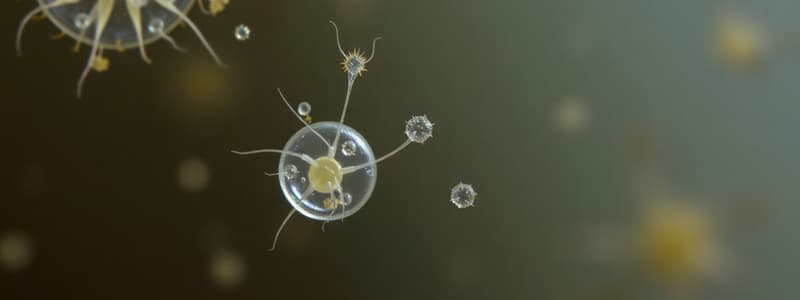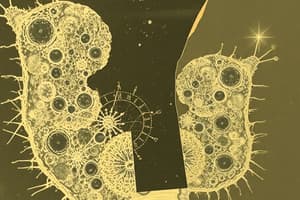Podcast
Questions and Answers
Which of the following statements best describes the classification of fungi?
Which of the following statements best describes the classification of fungi?
- Fungal classification depends on their habitats, type of mycelia, and modes of growth. (correct)
- The classification of fungi is primarily concerned with their reproductive structures.
- All fungi are classified as either yeasts or bacteria.
- Fungi are classified solely based on their modes of reproduction.
What is a common mode of reproduction in fungi?
What is a common mode of reproduction in fungi?
- Both binary fission and budding. (correct)
- Only budding.
- Binary fission only.
- Reproduction occurs exclusively through spores.
Which statement highlights the importance of fungi in ecosystems?
Which statement highlights the importance of fungi in ecosystems?
- Fungi exclusively decompose animal matter.
- Fungi only grow in aquatic environments.
- Fungi contribute to soil health and nutrient cycling. (correct)
- Fungi are primary producers in food chains.
Which of the following is an example of a pathogenic fungus?
Which of the following is an example of a pathogenic fungus?
Which technique is most commonly employed to identify fungal species?
Which technique is most commonly employed to identify fungal species?
What is the primary classification level used in binomial nomenclature for organisms?
What is the primary classification level used in binomial nomenclature for organisms?
Which of the following protozoa is known to cause Leishmaniasis?
Which of the following protozoa is known to cause Leishmaniasis?
Which of the following is NOT a common method of reproduction in protozoa?
Which of the following is NOT a common method of reproduction in protozoa?
What role do protozoa play in ecosystems?
What role do protozoa play in ecosystems?
Which of the following techniques is commonly used for the identification of protozoa?
Which of the following techniques is commonly used for the identification of protozoa?
Which protozoan disease is often referred to as 'sleeping sickness'?
Which protozoan disease is often referred to as 'sleeping sickness'?
In which taxonomic domain do protozoa fall?
In which taxonomic domain do protozoa fall?
What is a common method of reproduction for protozoa?
What is a common method of reproduction for protozoa?
Which of the following is NOT classified as a protozoa?
Which of the following is NOT classified as a protozoa?
How do protists generally ingest food?
How do protists generally ingest food?
Which of the following protozoa stages is known to be the feeding and multiplying phase?
Which of the following protozoa stages is known to be the feeding and multiplying phase?
What is the primary role of protozoa in ecosystems?
What is the primary role of protozoa in ecosystems?
Which protozoan is primarily associated with causing malaria?
Which protozoan is primarily associated with causing malaria?
Which type of protozoa generally move using cilia?
Which type of protozoa generally move using cilia?
Identify a characteristic feature of the cyst stage in protozoa.
Identify a characteristic feature of the cyst stage in protozoa.
What is the primary mode of locomotion for flagellated protozoa?
What is the primary mode of locomotion for flagellated protozoa?
Which of the following protozoa is known for being intracellular pathogens?
Which of the following protozoa is known for being intracellular pathogens?
Flashcards are hidden until you start studying
Study Notes
Protozoa - Key Notions
- Protozoa are unicellular eukaryotes
- Found in almost every habitat
- Can ingest complex food particles through the cytostome (mainly flagellates)
- Can be extracellular (blood, mucosa) or intracellular (cell ingestion)
- Protozoa can ingest nutrients directly through either cytoplasm or direct nutrient uptake
- Protozoa can move by pseudopodia, appear flagellated, or ciliated
- Most protozoa reproduce asexually by binary division, but some reproduce sexually
- Protozoa examples include: Entamoeba gingivalis, Acanthamoeba, Leishmania mexicana, Trichomonas vaginalis, Giardia lamblia, Balantidium coli, Plasmodium falciparum, Toxoplasma gondii, and Cryptosporidium
- Protozoa can exist in different stages of growth: cyst, trophozoite, and flagellated stages
Studying That Suits You
Use AI to generate personalized quizzes and flashcards to suit your learning preferences.





